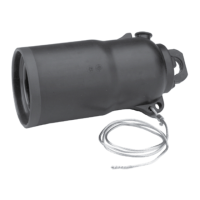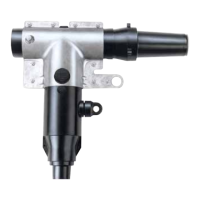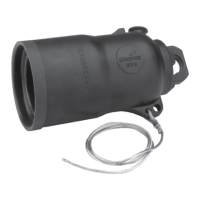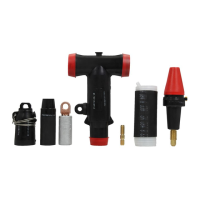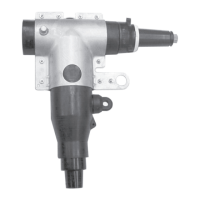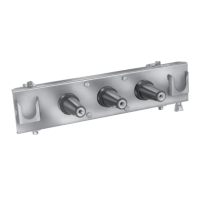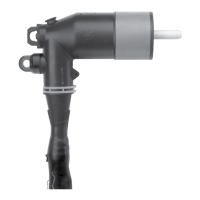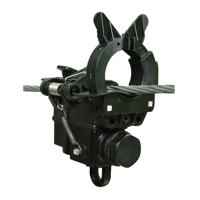IMPORTANT
To avoid damage to the wiring or batteries, do not
transport the control with the batteries installed.
Control power
The control voltage is auto-ranging from 96 to 265 VAC.
Battery replacement and disposal
The 24 VDC control battery has a life expectancy of four
years. It is recommended that the battery be replaced after
four years or if the battery fails a battery test (after sufficient
recharge time) – whichever occurs first.
ote:N Battery life is decreased at higher temperatures.
Dispose expired batteries in an environmentally responsible
manner. Consult local regulations for proper battery
disposal.
Operation upon loss of AC power
The control can be equipped with either an 8 Amp-Hour
or 13 Amp-Hour 24 VDC lead acid battery for operation
upon loss of AC power. The control maintains full operation
from the battery for a period of time dependent upon the
batterysize:
8 Amp-Hour – 24 hour maximum (20°C)
13 Amp-Hour – 36 hour maximum (20°C)
The control continuously monitors the battery voltage.
To prevent battery damage, the control shuts down
automatically upon detection of low battery voltage
(below 21 VDC) for 60 seconds. Refer to Testing section
for additional battery monitoring information.
Control programming settings and parameters – including
sequence of events recorder and data profiler – are stored
in non-volatile memory and retained upon loss of control
power. The time/date clock will continue to operate for
approximately four days after loss of control power (battery
and AC power). After this time period elapses, the control
time will be set to 12:00 AM, Jan. 1, 1970.
The control clock may require resetting if the operating
power has been disconnected for more than four days.
Refer to Service Information S280-104-2 Form 4D
Microprocessor-Based Recloser Control Programming Guide
for information on setting the control clock.
ote:N When AC power is present, the control will operate
regardless of back-up battery presence.
If B-phase (or the user-indicated phase) loses AC power and
the applicable alarm is configured by the user, the ALARM
red indicator LED will illuminate and the ALARM log on the
LCD Display will indicate NO AC PRESENT.
IMPORTANT
If the control shuts down due to low battery voltage
before AC power is restored, and the connected
energized recloser is CLOSED, no operations are possible
until AC power is restored or the battery is replaced
andconnected.
A control that has shut down due to low battery voltage
before AC power is restored will have a blank LCD
display (no text message shown).
Battery Monitoring
Battery monitoring occurs whether AC power is being
supplied or not.
Battery monitoring occurs every 1 – 2 seconds
This Battery monitoring does not take place during a
battery test.
The BATTERY LED will illuminate for the following conditions:
Battery voltage rises above 37 volts.
Battery voltage drops below 22 volts for 60 seconds.
Form 4D control is operating on battery power only and
battery voltage drops below 21 volts for 60 seconds. At
this time, the battery disconnect alarm is issued.
Battery test failure.
If the Form 4D control is still operating on battery power
and the battery voltage is still below 21 volts for 60 seconds
after a battery disconnect alarm has been issued, the
battery is disconnected from powering the control and the
control shuts down.
The BATTERY LED will turn off if the battery voltage is
below 37 volts and above 22 volts for 30 seconds.
Form 4D Recloser control description
Description
The Form 4D pole-mount microprocessor-based recloser
control includes extensive system protection functionality,
including phase and ground overcurrent protection, over/
underfrequency and voltage protection, sensitive ground
fault, and sync check.
Analysis tools include sequence of events recording, TCC
Editor
TM
II, and data profiler.
Metering functions include demand and instantaneous
current on a per-phase basis, instantaneous voltage and
power factor on a per-phase basis, and power (real, reactive,
apparent) on a per phase or total basis. Symmetrical
components for both voltage and current are displayed
along with kilowatt-hours for energy metering. Harmonics
from the 2
nd
to the 15
th
harmonic are also included.
2 OPERATION INSTRUCTIONS MN280049EN September 2017
Form 4D Microprocessor-based pole-mount recloser control installation and operation instructions

